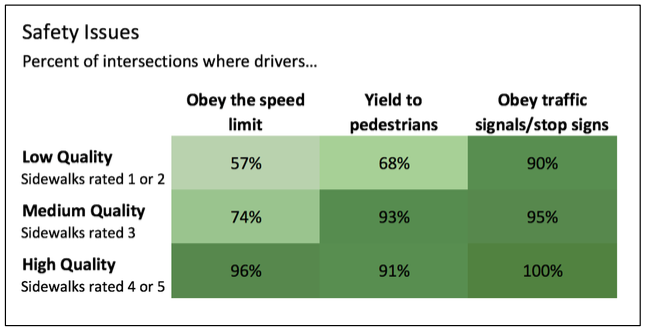Chaffee Park’s Streets Need an Overhaul to Make Them Walkable

Chaffee Park is a north Denver neighborhood scrunched between three highways. Like a lot of neighborhoods in the city, it suffers from street designs that prioritize the movement of car traffic over the safety of people. People who walk in the neighborhood know it’s a terrible and dangerous pedestrian environment. Now a new study maps out those problems block-by-block.
The study comes from Cultivate Health, a partnership of neighbors, nonprofits, and developers led by Regis University, which calls Chaffee Park home. With this study, the group hopes to show how to improve health in the neighborhood by making it more walkable.

WalkDenver teamed up with Cultivate Health on the study by mapping the area on WalkScope, a crowd-sourcing tool that lets users rate sidewalks and intersections and identify barriers to walking, like a lack of crosswalks or good connections to transit.
Trained data collectors recorded information about 521 sidewalks and 161 intersections in Chaffee Park. As you’ll see below, the WalkScope results illustrate a stunningly pathetic environment for pedestrians (read: all of us).
WalkScope uses a scoring system from 1 (low quality) to 5 (high quality). Eighty percent of both sidewalks and intersections received a score of 3 or less. Data collectors deemed 7 percent of sidewalks and 6 percent of intersections to be high-quality infrastructure.
The most glaring problem with Chaffee Park’s sidewalks is that most are too narrow and uneven, even if they abut busy streets. Only 20 of the 521 blocks of sidewalks surveyed were wider than 5 feet, the minimum acceptable width. Of the sidewalks surveyed, 53 percent were “rollover curbs,” which are less than 3 feet wide and “basically an extension of the curb that is intended to be driven over,” according to the study.
The study also makes a key connection between the quality of intersections for pedestrians and driver behavior. Unsurprisingly, when intersections lacked crosswalks, medians, or traffic signals, drivers were more reckless. Only 5 percent of the intersections studied had marked crosswalks in all directions, and just 6 percent had any marked crosswalks at all. Observers found Federal Boulevard especially dangerous.

The authors make 16 very specific short-term and long-term recommendations, ranging from widening sidewalks to installing medians along Federal Boulevard between 48th and 52nd avenues.
The report is easily digestible and has a ton more information. The question is, what’s next? Safe sidewalks and crosswalks are basic rights for any city dweller, but Mayor Michael Hancock has yet to create a funding mechanism to ensure every neighborhood has them. It’s primarily up to property owners to maintain sidewalks.
One option is to revive an idea from 2002 that never got off the ground. The policy would charge owners a fee based on the amount of space in front of their property, and add it to a dedicated pedestrian infrastructure fund. The Cultivate Health study — and others like it — arms advocates with data to support the need for such a fund. The Hancock Administration would be hard-pressed to ignore it.


